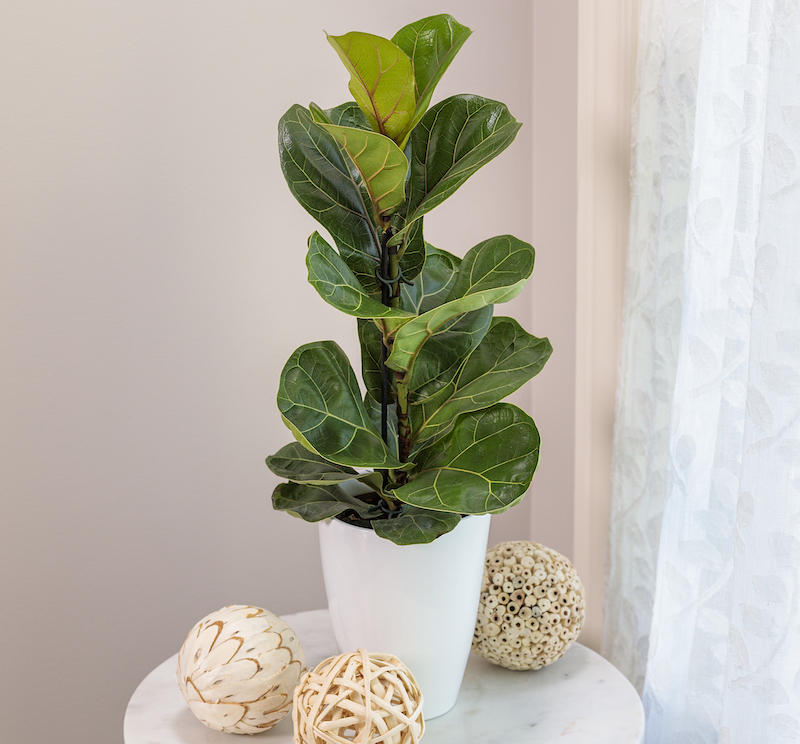How should you care for a ficus grown in a container versus the ground? Like all plants, when grown in containers, ficus needs you to resupply its soil with the necessary nutrients after it has depleted them; whereas, when grown in the ground, ficus primarily depends on natural cycles to complete the same task. Also, due to the small volume of soil available to a potted ficus, it depletes the available nutrients at a fast rate, so you need to replenish it more often than nature does.

Why Fertilize Ficus
Since this perennial continuously withdraws nutrients from the soil, these nutrients must be replenished. Without a resupply, ficus won’t be able to conduct its normal growth processes. Additionally, since stressed plants are more likely to be targeted by pests disease, the problems may only compound if ficus is underfed.
Resupplying your ficus’s soil with nitrogen, phosphorus, and potassium will help this ornamental remain healthy and vibrant. Nitrogen encourages plant growth, phosphorus enhances root growth, and potassium promotes the movement of nutrients and water throughout the plant. Just make sure to feed this evergreen with the appropriate amount of fertilizer at the proper time. Do not overfeed ficus, as too much fertilizer can burn the roots and leaves. Since a plant’s growth rate decreases during its dormant phase, ficus requires little fertilizer during winter.

How Often To Fertilize Ficus
Since ficus is a fast grower, use a liquid fertilizer monthly during its growing season, from early spring until late fall. However, refrain from feeding ficus during its dormant phase in the winter. A balanced N-P-K fertilizer such as a 10-10-10 will suffice, but to better support its growth, you can select a fertilizer formulated for indoor tropical plants.
How To Tell If Ficus Needs Fertilizer
Are you loving ficus’s shiny emerald green foliage? Your heart will sink upon seeing its leaves turn yellow. Yellow leaves can be a sign of nitrogen or potassium deficiency. Green leaves with a purplish tint, accompanied by stunted growth, indicate phosphorus deficiency.
Any deficiency in macronutrients nitrogen, phosphorus, and potassium will likely produce discolored leaves along with curled, wilted, drooping, dropping leaves and stunted growth. Resupplying whichever nutrient ficus lacks will probably correct the problem.
Best Fertilizer For Ficus
Feed Ficus a balanced N-P-K fertilizer formulated for indoor tropical plants. Two great organic fertilizers are FoxFarm Grow Big - Liquid Concentrate (6-4-4) and Espoma Organic Indoor! (2-2-2) liquid fertilizer. FoxFarm advises mixing 2-3 teaspoons of Grow Big per gallon of water and feeding once or twice each month. Espoma advises mixing two teaspoons of food per quart of water and drenching the soil every time you apply it.
Ficus Fertilizing Tips
To encourage ficus’s growth, feed it a balanced (N-P-K) liquid fertilizer monthly during its growing season, from spring until early fall. Two outstanding organic fertilizers to try are FoxFarm Grow Big - Liquid Concentrate (6-4-4) and Espoma Organic Indoor! (2-2-2) liquid fertilizer.
- Ficus grown in containers requires you versus nature to resupply its nutrients.
- Fertilize ficus monthly during its growing season.
- If the leaves yellow, wilt, curl, or drop, ficus may need fertilizer.
- FoxFarm Grow Big - Liquid Concentrate (6-4-4) and Espoma Organic Indoor! (2-2-2) liquid fertilizer are good options to feed ficus.
Warnings
-Always wear protective gloves and a face mask when handling chemical fertilizers.
-Closely follow all directions and storage guidelines that are on the fertilizer label.
 |
Author Suellen Barnes - Published 6-01-2023 |
